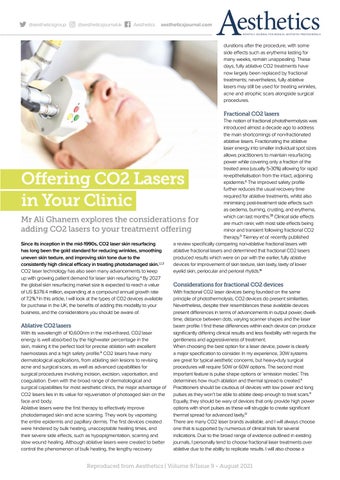@aestheticsgroup
@aestheticsjournaluk
Aesthetics
aestheticsjournal.com
durations after the procedure, with some side effects such as erythema lasting for many weeks, remain unappealing. These days, fully ablative CO2 treatments have now largely been replaced by fractional treatments; nevertheless, fully ablative lasers may still be used for treating wrinkles, acne and atrophic scars alongside surgical procedures.
Fractional CO2 lasers The notion of fractional photothermolysis was introduced almost a decade ago to address the main shortcomings of non-fractionated ablative lasers. Fractionating the ablative laser energy into smaller individual spot sizes allows practitioners to maintain resurfacing power while covering only a fraction of the treated area (usually 5-30%) allowing for rapid re-epithelialisation from the intact, adjoining epidermis.6 The improved safety profile further reduces the usual recovery time required for ablative treatments, whilst also minimising post-treatment side effects such as oedema, burning, crusting, and erythema, which can last months.7,8 Clinical side effects Mr Ali Ghanem explores the considerations for are much rarer, with most side effects being adding CO2 lasers to your treatment offering minor and transient following fractional CO2 therapy.9 Tierney et al. recently published Since its inception in the mid-1990s, CO2 laser skin resurfacing a review specifically comparing non-ablative fractional lasers with has long been the gold standard for reducing wrinkles, smoothing ablative fractional lasers and determined that fractional CO2 lasers uneven skin texture, and improving skin tone due to the produced results which were on par with the earlier, fully ablative consistently high clinical efficacy in treating photodamaged skin.1,2,3 devices for improvement of skin texture, skin laxity, laxity of lower CO2 laser technology has also seen many advancements to keep eyelid skin, periocular and perioral rhytids.10 4 up with growing patient demand for laser skin resurfacing. By 2027 the global skin resurfacing market size is expected to reach a value Considerations for fractional CO2 devices of US $378.4 million, expanding at a compound annual growth rate With fractional CO2 laser devices being founded on the same of 7.2%.5 In this article, I will look at the types of CO2 devices available principle of photothermolysis, CO2 devices do present similarities. for purchase in the UK, the benefits of adding this modality to your Nevertheless, despite their resemblances these available devices business, and the considerations you should be aware of. present differences in terms of advancements in output power, dwelltime, distance between dots, varying scanner shapes and the laser Ablative CO2 lasers beam profile. I find these differences within each device can produce With its wavelength of 10,600nm in the mid-infrared, CO2 laser significantly differing clinical results and less flexibility with regards the energy is well absorbed by the high-water percentage in the gentleness and aggressiveness of treatment. skin, making it the perfect tool for precise ablation with excellent When choosing the best option for a laser device, power is clearly haemostasis and a high safety profile.6 CO2 lasers have many a major specification to consider. In my experience, 30W systems dermatological applications, from ablating skin lesions to revising are great for typical aesthetic concerns, but heavy-duty surgical acne and surgical scars, as well as advanced capabilities for procedures will require 50W or 60W options. The second most surgical procedures involving incision, excision, vaporisation, and important feature is pulse shape options or ‘emission modes’. This coagulation. Even with the broad range of dermatological and determines how much ablation and thermal spread is created.11 surgical capabilities for most aesthetic clinics, the major advantage of Practitioners should be cautious of devices with low power and long CO2 lasers lies in its value for rejuvenation of photoaged skin on the pulses as they won’t be able to ablate deep enough to treat scars.9 face and body. Equally, they should be wary of devices that only provide high power Ablative lasers were the first therapy to effectively improve options with short pulses as these will struggle to create significant photodamaged skin and acne scarring. They work by vaporising thermal spread for advanced laxity.12 the entire epidermis and papillary dermis. The first devices created There are many CO2 laser brands available, and I will always choose were hindered by bulk heating, unacceptable healing times, and one that is supported by numerous of clinical trials for several their severe side effects, such as hypopigmentation, scarring and indications. Due to the broad range of evidence outlined in existing slow wound healing. Although ablative lasers were created to better journals, I personally tend to choose fractional laser treatments over control the phenomenon of bulk heating, the lengthy recovery ablative due to the ability to replicate results. I will also choose a
Offering CO2 Lasers in Your Clinic
Reproduced from Aesthetics | Volume 8/Issue 9 - August 2021


















